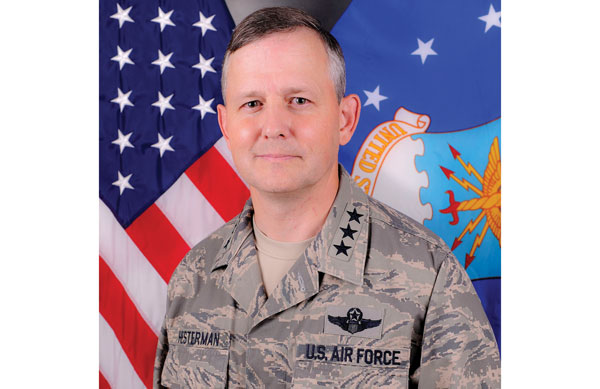2013-12-01
Lt Gen John Hesterman:We work with allies to protect mutual interests and ensure stability
By Sakha Pramod
Lt Gen John Hesterman Commander, US Air Forces Central Command, Southwest Asia, talks exclusively to Nation Shield at the Dubai Airshow. Excerpts:
You have flown during the first night of Operation Desert Storm and were the expeditionary squadron commander for multiple operations. Can you tell us about your operational experience in the Middle East?
I’ve been fortunate to spend a lot of time in the Middle East and be part of some remarkable operations, all of which were made even more significant because I was part of a team consisting of regional allies and Coalition partners that have played an important role in maintaining regional security for many years.It is even more rewarding to be working with air chiefs that I flew side-by-side with so many years ago.
Heading the Central Command, South West Asia, you are responsible for developing contingency plans and conducting air operations in a 20-nation area of responsibility covering Central and Southwest Asia. How difficult is it to coordinate activities in such a wide area of operation?
As the commander of US Air Forces Central Command (USAFCENT), which is the air component to US Central Command (USCENTCOM), headed by General Austin, we work very closely with our partners through events like combined training opportunities and regional security exercises. It is through these training opportunities and exercises that we learn valuable lessons from one another in an effort to increase our interoperability with our partners and demonstrate our continued commitment to cooperative defense agreements and regional security.
The important thing to remember is that these bilateral and multilateral exercises and training events improve the ability of our friends and allies to work together protecting mutual interests, deterring conflict, and ensuring stability in the region.
The US Air Force’s MQ-1 Predator and MQ-9 Reaper remotely piloted aircraft recently accumulated two million flight hours on October 22, not only marking a significant milestone, but also demonstrating the evolution of the program. How significant is this feat for the operations of Central Command, Southwest Asia?
We’re immensely proud that these persistent Intelligence, Surveillance and Reconnaissance (ISR) and precision-strike platforms have reached this milestone. But perhaps the bigger story and true achievement has been the unwavering dedication of the men and women who have made this capability available for such a sustained period of time. They have saved lives and made our coalition stronger, safer and more secure.
Information from the RPAs are said to feed intelligence that allows someone to make a better decision - in peacetime and war. Can you elaborate?
ISR’s purpose is to inform decision-makers. Remotely piloted aircraft do just that, delivering vital ISR during both contingency operations, such as Afghanistan, and humanitarian relief operations, such as the 2010 flooding in Pakistan. But the platforms are only one small piece of the puzzle, the collection piece. The information must still be processed and disseminated to decision makers. This requires a robust network of highly skilled individuals in numerous locations working tirelessly to ensure mission success.
To what extent do you use RPAs for anti-terrorist operations in the Middle East?
The primary mission set for RPA is intelligence, surveillance and reconnaissance. Only about three per cent of all RPA sorties over Afghanistan involve kinetic events. We often spend days, weeks or longer surveilling areas of interest to help commanders develop a full understanding of the battlespace.
When and if sorties go kinetic, they do so with unprecedented battlespace awareness. Additionally, protecting civilians and minimizing collateral damage remains at the very core of USAFCENT’s mission. The use of all USAFCENT aerial weapons is tightly restricted, meticulously planned, carefully supervised and coordinated, and applied by extremely well-qualified personnel.
The important take-away is that the US Air Force’s contribution to the Intelligence, Surveillance and Reconnaissance enterprise is vital to the national security of the United States and its allies, providing an unrivaled capability, greatly reduced collateral damage, and extremely precise kinetic effects.
Can you tell us about your peacetime operations and how important they are to maintain stability in any region?
Everything we do is aimed at maintaining partnerships and promoting stability in this region. As part of the US Government’s commitment to regional security, USCENTCOM and USAFCENT are committed to working cooperatively to improve the operational capability of our partners in the region.
US participation in combined training opportunities enhances regional partnerships, supports regional security, and demonstrates a continued commitment to regional stability. The strong military-to-military ties we have with our close allies in the region play an important role in maintaining stability in Southwest Asia.
Biography
Lt. Gen. John Hesterman is Commander, U.S. Air Forces Central Command, Southwest Asia. As the Air Component Commander for U.S. Central Command, the general is responsible for developing contingency plans and conducting air operations in a 20-nation area of responsibility covering Central and Southwest Asia. General Hesterman grew up in an Air Force family and graduated from the U.S. Air Force Academy in 1983. He has served in a variety of positions in the Middle East, Europe, Asia, and the United States, and has held staff assignments on the Air Staff, Joint Staff, and Office of the Secretary of Defense staff. The general has commanded the 494th Fighter Squadron, the 4th Operations Group, the 12th Flying Training Wing, and the 48th Fighter Wing. General Hesterman has served as an instructor pilot in the F-16C, F-117A, F-15E and T-38C. He flew on the first night of Operation Desert Storm and served as an expeditionary squadron commander in operations Provide Comfort, Deny Flight, Deliberate Guard, and Northern Watch. He also served as U.S. Central Command’s Deputy Combined Force Air Component Commander. A highly decorated officer, he has won, among others, Bronze Star Medal,
Meritorious Service Medal with two oak leaf clusters, Air Medal with three oak leaf clusters, Aerial Achievement Medal and Air Force Commendation Medal with oak leaf cluster.


No Comments